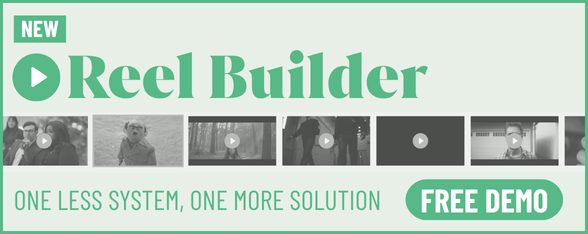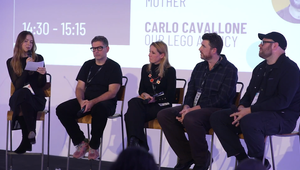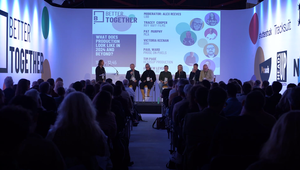
LBB Better Together 2024: “Trust Is the Most Important Ingredient”

“Lean in, take that leap, grab each others’ hands and do it together. You’ll learn more and be part of something.” For Matt Watson, ECD at Pepsico’s in-house agency Sips & Bites, collaboration and partnership are key when it comes to navigating the whirlwind of change facing the industry.
New tech, new opportunities, new challenges, and new competition – there’s a lot happening in the industry right now. So how can the advertising community harness the collegiate spirit that has made it so great for so long to show up and shine, even as some of these changes bring new tensions to the fore? That’s the question at the heart of LBB’s debut Better Together summit in London this week.
Hosted at Park Village in Camden, the event brought together experts from brands like KFC, Cadbury and Guinness; production companies and agencies like Stink, Riff Raff and Heads Up Production; creative agencies like Mother and Uncommon; in-house hot shops Sips & Bites and Our Lego Agency; and innovators like Shutterstock Studios and Whalar.
The event busted silos and opened up conversations between parts of the industry that don’t always get the chance to talk, or really get to grips with the challenges facing their clients and partners.

What Does the Market Look Like Right Now?
The introductory talk saw Alex Brownsell, head of content at WARC, and Sarah Virani, senior commercial manager at the Advertising Association, presenting key industry insights to paint a picture of what the market looks like right now, and where it’s headed.
Alex discussed where the money is going, in a year where global ad spend is forecasted to hit $1.07 trillion for the first time. The global ad market is increasingly dominated by digital, particularly social media – formats prone to AI disruption. Alphabet, Amazon, and Meta alone account for 44%, accounting for not only paid media spend, but also use of their AI tools. In terms of TV ad revenue, globally it’s been “the hardest year in terms of year-on-year drop [...] But the UK’s TV market is actually pretty resilient.” Content is still king, but streamers have been providing a boost, with traditional broadcasters increasingly collaborating with the likes of Netflix, Amazon Prime, and Disney+.
Sarah Virani, senior commercial manager at the Advertising Association, followed up with thoughts on how advertising can bolster the UK’s growth – though money is tight, it’s still an important part of the nation’s ‘soft power’. Sarah highlighted three main areas to consider: public trust, which is rising for the first time in a decade, often driven by creativity, and critical for business success; talent, with representation and belonging being key points of focus; and climate action. All three must work together. “We are all dependent on each other for progress.”

What Do Modern Brands REALLY Need?
LBB’s editor-in-chief, Laura Swinton, asked giants from the brand world the burning question: “What do modern brands really need?” In a time of rising costs and shifting consumer behaviour, they emphasised the necessity of balancing bold creativity with data-driven pragmatism and trust. “It’s not about making things cheaper, but making sure what you’re offering feels worth it,” said Magnum’s Benjamin Curtis.
Trust was a recurring theme and a non-negotiable in the brand/agency dynamic. Simon Valcarcel of Virgin Media O2 underscored the importance of long-term agency partnerships to “manage the minefield”. KFC UK’s Kate Wall shared a similar sentiment, citing the risk-taking involved in their daring ‘Believe In Chicken’ campaign – only possible through deep trust in agency partners. She admitted to unprecedented anxiety before the launch, demonstrating the high stakes for brands trying to stand out – and this time – the fruits of the brave idea. Most rely on agencies to shepherd in production partners that fit the brand’s needs, while advice to smaller production companies wanting to partner with big brands is to invest in up-and-coming director talent.
Data also plays a pivotal role in shaping strategy. As Simon highlighted, convincing non-marketing stakeholders of creativity’s value remains a battle, making demonstrable results essential. Benjamin illustrated how smart data use helped the brand address knock-off competition through a playful, consumer-centric campaign. However, Kate raised an important counterpoint: data, while valuable, is no substitute for big creative ideas that connect on a human level.
Ultimately, the panel concluded that for brands to thrive today, they need a deft combination of trust in partners, risk-taking creativity, and the smart application of data – all while ensuring every penny spent drives value.

What Does Production Look Like in 2024 and Beyond?
Next on the agenda, LBB’s managing editor EMEA, Alex Reeves, took the stage to ask what the production landscape looks like today, and where it’s headed. Joining him were Tracey Cooper, executive producer at RiffRaff; Andrew Levene, managing director at Stink; Pat Murphy, founder and CEO at MCA; Victoria Keenan, head of production at BBH; Tim Page, partner and director of production at HeadsUp Production; and Paul Ward, president, global network and CEO UK of Prose on Pixels.
The discussion highlighted the importance of collaboration, creativity and innovation. Trust, once again, emerged as a key point in partnerships, echoing the previous panel – the speakers agreed that regardless of the route, trust needs to be present at every checkpoint.
Technology’s role, including virtual production and AI, was brought up when it came to enhancing efficiency, creativity and control of assets. Pat Murphy explained that “60% to 70% of all assets that get created don’t ever get used.” By leveraging AI, companies can avoid wastage, aligning with their sustainability goals. He added: “The best way to do sustainable production is to not produce anything at all.”
When it came to bringing in new talent to the production scene, the panellists emphasised their trust in younger creatives being able to leverage newly emerging platforms. They also underlined the importance of upskilling those who have been in the industry for long enough to remember a time before these platforms were relevant. New roles were discussed too, such as “AI rosters,” as Victoria Keenan mentioned.
Looking ahead, some speakers agreed that we will see fewer, but more specialised, production companies emerge. Andrew Levene said: “Bigger players will still be there because of good talent. Smaller companies need to do more specialised work and be incredibly good at it.”
Advice to marketers was clear: it’s essential to partner with trusted agencies and production partners who understand new technologies and can leverage them effectively. Collaboration and trust are paramount, as is selecting partners who are agile and innovative.

How We Reignited Guinness
Gráinne Wafer, global director of Guinness at Diageo, visited from Dublin to tell us how Diageo “reignited Guinness”. Gráinne began by noting that standing on the shoulders of giants can weigh heavily – something felt acutely when it comes to Guinness’ advertising. She shared that back in 1929, Rupert Guinness didn’t want to advertise. He said he would agree on the condition that, “The quality of our advertising must be equal to the quality of our beer.”
Gráinne said challenges for the brand began before covid, with shifting media consumption, marked by a move into social, digital, and culture-first. Socially, things were changing too, “Guinness was no longer cool – and the business was feeling it… A young, diverse audience was the avenue back to growth.” Gráinne said that success meant saying goodbye to the old marketing mode, moving away from the perfectly defined brand, and becoming instead, a community-first brand.
This was achieved through the three fundamentals. First off, ‘Quality’ utilised social listening, creating ‘Rituals’ – a social initiative that grew reach by 182% in 2023 and 10 million views online. Secondly, ‘Distinctiveness’ bastioned Guinness’ iconic black and white identity superpower, drifting away from a top-down approach, collaborating with creatives instead. Finally, ‘Innovation’ took inspiration from the genius lengths Guinness-drinkers were going to for the perfect pint at home, creating the Nitrosurge and launching the ‘Perfect Pours’ platform.
As a result, Guinness became a peer of communities, driving sales and recruiting consumers – most impressively a 27% increase in female Guinness drinkers. Gráinne’s advice to brands hoping to garner success was to start with social, know your truth, and build for agility.

How Are Agencies Evolving?
The penultimate panel discussed the rapid evolution of the agency, with insights from Natalie Graeme, founder, Uncommon; Chris Gallery, head of strategy, Mother; and in-house representation from Carlo Cavallone, VP of creative at Our LEGO Agency (OLA), the LEGO Group; and Matt Watson, executive creative director, Sips & Bites / PepsiCo; moderated by LBB’s UK editor Zhenya Tsenzharyk.
Asked about the biggest agency changes they’ve been seeing, the group cited a departure from film-centric advertising. As Chris pointed out, “the best creatives have always been really inquisitive and wanting to do new things”. At Uncommon, Natalie told us, the team have been exploring design, feature films, and even architecture, while Carlo mentioned LEGO’s recent movie with Pharrell Williams and gallery launch in Paris.
On the post-covid rise of freelancers, Carlo praised their “disruptive, interesting outside perspectives”; Matt offered an important caveat to having a fluid talent pool: clients buy into agencies as their own brands, so they need to remain consistent.
The reminder taps into one of the panel’s main talking points: knowing who you are, and why you are. Whether being bought, merging, or expanding into new media and capabilities, agencies must either remain true to their core vision or risk being perceived as having an identity crisis.
All panellists agreed upon a need to play nice across the board. Indies, in-house, and network agencies all have their merits, as Natalie emphasised that the pie is big enough for everyone. Agencies of any kind need to be made up of good humans that partners can connect with, who set their egos aside. Chris said it best: “If [we] want to do something great, we all need each other.”

Successful New Models: A Deep Dive into Innovative Making and Creating
Next up, Matt Cooper brought Andrew Swinand, CEO at ITG; Emma Harman, president EMEA of Whalar Group; Rochelle Palmer, MD at Untold Studios; Aiden Darné, VP and head of global production at Shutterstock; and Amina Folarin, UK CEO of OLIVER on stage to tackle the intersection of creativity, technology and marketing. Each of these companies changed the game, as Matt noted, and found a way to work the reinvented wheel. Clearly-defined, easy boxes to tick are out of the window – and it is these leaders in the industry that have emerged in the ‘in-between’ spaces, taking the whole landscape by a storm from there.
Where novelty is mentioned, AI leads the conversation. ITG’s Andrew Swinand explained the numerous ways in which AI can make creatives’ lives easier – referencing previously mentioned waste of assets, he added that “20% of companies’ time is spent only looking for assets,” and 80% of the content in DAMs is never picked up again. Using AI for meta tagging, tracking and optimising is a game-changer.
However, balance between technology and creativity was underlined as essential, with the focus on human craft remaining critical, despite the rise of AI usage. A strong tech stack is vital, but people remain at the helm of the creative.
Panellists emphasised the need for adaptability, a theme that reemerged in nearly every discussion. In the face of economic downturns, changes in consumer behaviour and industry challenges, agility becomes a survival instinct. “There will always be market forces that work against you, it’s about how you adapt to them,” said Rochelle. However, flexibility and trial and error aren’t an issue for those with innovation baked into their DNA.
Emma explained that all of Whalar’s work is so forward facing and experimental, that for their people, bravery is second nature: “Trying things out is the nature of what we do. That’s what clients come to us for – not for a safe bet.”
Successful partnerships with clients were celebrated – Unilever, Diageo and Heineken – but a few common denominators characterised them all: deep collaboration, understanding and being an extension of clients’ teams. A focus was placed on community-based marketing rather than surface-level demographic targeting by age and country. Recognised was the importance of connecting brands with authentically emerging niches they should be part of.

Parting Thoughts
From each corner of the industry today, the message feels hopeful. The future of advertising is not about surviving change, but owning it as one. At a time when technology accelerates faster than we can grasp, and challenges multiply, collaboration isn’t just a strategy – it’s a lifeline. The task demands collective courage.
We’ve always thrived on creativity, but now, we must create with purpose, with boldness, knowing that above all, we are better together.
A big thanks to our sponsors
Shutterstock | Park Village | Peach | NaF | Heads Up Production | Tracksuit
















